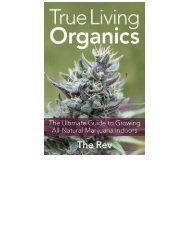You also want an ePaper? Increase the reach of your titles
YUMPU automatically turns print PDFs into web optimized ePapers that Google loves.
*Amounts listed are for addition <strong>to</strong> approximately 2 gallons of moist kitchen scraps*<br />
I don’t add all of these elements every time I feed the worms.<br />
4 cups perlite<br />
1–2 cups well-rinsed coconut coir fiber<br />
1 tablespoon greensand<br />
2 tablespoons crushed or ground oyster shell<br />
1 tablespoon granular rock phosphate<br />
¼ cup all organic alfalfa pellets<br />
2 tablespoons kelp<br />
2 tablespoons humate (humic acid ore shale)<br />
Plenty of dried cannabis leaves, stems, and roots<br />
2 cups shredded junk mail/paper<br />
To a typical 2 gallons of kitchen scraps and cannabis plant matter, I would always want either some<br />
eggshells or crushed oyster shells in the mix <strong>to</strong> bring some additional calcium and for some pH<br />
buffering. Don’t add lime, dolomite or otherwise; these have never turned out well for me at any rate.<br />
Make sure you use Red Wiggler worms, and make double sure you won’t get freaked out by a few<br />
fruit flies or gnats here and there. I can tell you right now that no TLO super natural grow is going <strong>to</strong><br />
be bug-free. <strong>The</strong>y are attracted <strong>to</strong> the pristine all natural conditions that TLO brings <strong>to</strong> the table; it<br />
invites and enhances life. Who knew?<br />
You may be wondering why you’ll need all the minerals. Minerals break down pretty fast when in<br />
proximity <strong>to</strong> high levels of bioactivity from the microbial life. <strong>The</strong>se minerals are ones that are hard<br />
<strong>to</strong> make available all naturally, like phosphorus, potassium, calcium, and many micro and secondary<br />
nutrients as well. <strong>All</strong> those are very important <strong>to</strong> your grow, especially during flowering for large<br />
yields.<br />
<strong>The</strong> calcium from the oyster shells is awesome, and so is the pH buffering. <strong>The</strong> coconut coir fiber<br />
is a fairly effective pH buffer <strong>to</strong>o, and the worms also seem <strong>to</strong> really love having it around. When the<br />
coir breaks down (which it does pretty quickly in TLO) it brings decent amounts of K in<strong>to</strong><br />
availability in the soil mix. If your earthworm food seems <strong>to</strong>o wet, just add some more shredded junk<br />
mail and dry coconut coir <strong>to</strong> it, and if it is <strong>to</strong>o dry just add some chlorine/chloramine free water or<br />
more moist kitchen scraps. <strong>The</strong> real key is <strong>to</strong> keep it somewhat moist, but never dry.



